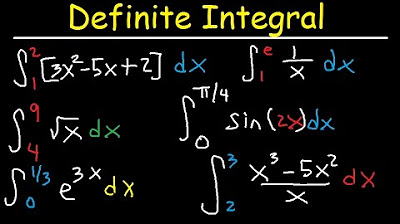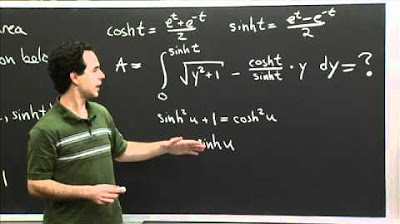U-Substitution with Definite Integrals
TLDRThis educational video script offers a detailed tutorial on solving definite integrals using the method of u-substitution. It walks through multiple examples, including integrals involving x * (x^2 + 1)^3 and x * (1 + 2x^2)^(-2), demonstrating the process of substitution, finding antiderivatives, and evaluating the results. It also covers the application of u-substitution to trigonometric functions and introduces the concept of Riemann sums for approximating areas under a curve, providing a comprehensive guide for students learning calculus.
Takeaways
- 📚 The video is a tutorial on handling definite integrals using U-substitution.
- 🔍 The first example involves integrating x * (x^2 + 1)^3 from 1 to 2, using x^2 + 1 as the substitution for U.
- 📐 The derivative du/dx is calculated as 2x, leading to the substitution dx = du/(2x).
- 🔄 The boundaries of integration are also substituted using the U = x^2 + 1 relationship, resulting in new limits from U=2 to U=5.
- 🧩 The integral is then transformed into an integral in terms of U, which simplifies the problem.
- 📈 The anti-derivative of U^3 is found to be (U^4)/4, and evaluated between the new limits.
- 🔢 The second example integrates a function with a trigonometric term, using 1 + 2x^2 as the substitution for U.
- 📉 The function is rewritten to facilitate the substitution, and the new integral in terms of U is set up.
- 📏 The third example involves a trigonometric function with U = 3x, and the integral is evaluated from pi/4 to pi/3.
- 📘 The anti-derivative for the sine function is used, and the result is simplified by evaluating the cosine at the given limits.
- 📏 The final example calculates the area under the curve of x * (x^2 + 1)^(1/2) from 0 to 2, using the same U-substitution method.
- 📊 The video concludes with a brief mention of Riemann sums for approximating definite integrals, using a table of values for different intervals.
Q & A
What is the main topic of the video script?
-The main topic of the video script is how to handle definite integrals when u-substitution is involved.
What is the first example integral given in the script?
-The first example integral is ∫(x * (x^2 + 1)^3) dx from 1 to 2.
What is the u-substitution for the first example integral?
-For the first example, u is substituted as u = x^2 + 1.
How is the derivative of u with respect to x, du/dx, used in the first example?
-In the first example, du/dx is found to be 2x, and then the integral is rewritten as ∫(u^3 * (1/2) du) after substituting x dx with (1/2) du.
What is the process for finding the new limits for u after x-substitution?
-The process involves substituting the original x limits (1 and 2) into the u equation (u = x^2 + 1) to find the new u limits, which are 2 and 5, respectively.
What is the anti-derivative of u^3 found in the first example?
-The anti-derivative of u^3 is (u^4)/4.
How is the second example integral different from the first?
-The second example integral involves a different function and a different u-substitution, where u = 1 + 2x^2 and du/dx = 4x, leading to 1/4 du = xdx.
What is the anti-derivative of u^(-2) in the second example?
-The anti-derivative of u^(-2) is -2u^(-1/2), which simplifies to -2/√u.
What is the purpose of the left and right Riemann sums in the script?
-The left and right Riemann sums are used to approximate the area under the curve of a function over a given interval using data from a table with four subintervals.
How are the left Riemann sum and the right Riemann sum calculated differently?
-The left Riemann sum uses the function value at the left endpoint of each subinterval, while the right Riemann sum uses the function value at the right endpoint.
What is the final step in evaluating the definite integral using the anti-derivative?
-The final step is to evaluate the anti-derivative at the upper limit and subtract the evaluation at the lower limit.
Outlines
📚 Understanding Definite Integrals with U-Substitution
This paragraph introduces the concept of handling definite integrals using U-substitution. The example provided involves integrating from 1 to 2 of the function \( x \cdot (x^2 + 1)^3 \). The process begins by setting \( U = x^2 + 1 \) and solving for \( \frac{du}{dx} \), which leads to \( \frac{du}{dx} = 2x \). The integral is then transformed into \( \int_2^5 U^3 \cdot \frac{1}{2} du \) by substituting the bounds accordingly. The anti-derivative is found to be \( \frac{1}{4}U^4 \), and the final evaluation results in \( \frac{1}{4} \cdot 5^4 - \frac{1}{4} \cdot 2^4 \). Another example is discussed, where the integral involves a trigonometric function, and the process is similar, with \( U = 3x \) and \( \frac{du}{dx} = 3 \), leading to the integral \( \int_{\pi/4}^{\pi/3} \sin(U) \cdot \frac{1}{3} du \). The anti-derivative here is \( -\frac{1}{3} \cos(U) \), and the evaluation is performed from \( \pi/4 \) to \( \pi/3 \).
📈 Calculating Area Under the Curve Using Riemann Sums
The second paragraph delves into the application of Riemann sums to approximate the area under a curve. The example involves a function \( x \cdot (x^2 + 1)^{1/2} \), which is integrated from 0 to 2. The process starts by setting \( U = x^2 + 1 \) and solving for \( \frac{du}{dx} \), resulting in \( \frac{du}{dx} = 2x \). The integral is then rewritten as \( \int_1^5 U^{1/2} \cdot \frac{2}{3} du \) after substituting the bounds. The anti-derivative is \( \frac{2}{3}U^{3/2} \), and the evaluation yields \( \frac{2}{3} \cdot 5^{3/2} - \frac{2}{3} \cdot 1^{3/2} \). Additionally, the paragraph discusses the calculation of left and right Riemann sums using a table of function values and intervals, illustrating how to approximate the area under the curve by summing the products of function values and interval widths.
Mindmap
Keywords
💡Definite Integral
💡U-Substitution
💡Differential
💡Anti-Derivative
💡Fundamental Theorem of Calculus
💡Trigonometric Functions
💡Riemann Sum
💡Left Riemann Sum
💡Right Riemann Sum
💡Bounds of Integration
Highlights
Introduction to handling definite integrals with U-substitution.
Example given for integral from 1 to 2 of x * (x^2 + 1)^3.
U-substitution with U = x^2 + 1.
Solving for x dx to get 1/2 du = x dx.
Substituting boundaries for U to find U values at x = 1 and x = 2.
Integral rewritten with U substitution from 2 to 5 of U^3 * (1/2) du.
Finding the anti-derivative U^4/4 and evaluating from 2 to 5.
Second example with integral involving x * (1 + 2x)^(-2).
U-substitution with U = 1 + 2x^2 and du/dx = 4x.
Evaluating U at x = 0 and x = 2 to find bounds for new integral.
Integral transformed with U substitution from 1 to 9 of U^(-2) * (1/4) du.
Integration of U^(1/2) and application of the fundamental theorem of calculus.
Third example with trigonometric integral involving sin(3x).
U-substitution for trigonometric integral and finding bounds for U.
Integral from pi/4 to pi/3 of sin(U) * (1/3) du and finding anti-derivative.
Calculation of area bounded by the graph on the x-axis from 0 to 2.
Review of Riemann sums with data from a table for approximation.
Calculation of left Riemann sum using function values at left endpoints.
Calculation of right Riemann sum using function values at right endpoints.
Transcripts
Browse More Related Video

Integration of Rational Functions By Completing The Square - Calculus

Definite Integral Calculus Examples, Integration - Basic Introduction, Practice Problems

Average Value of a Function

Hyperbolic Trig Sub | MIT 18.01SC Single Variable Calculus, Fall 2010

Calculus AB Homework 6.7 U-Substitution

Definite Integrals from Graphs (Part 2 of 3) - U-Substitution
5.0 / 5 (0 votes)
Thanks for rating: